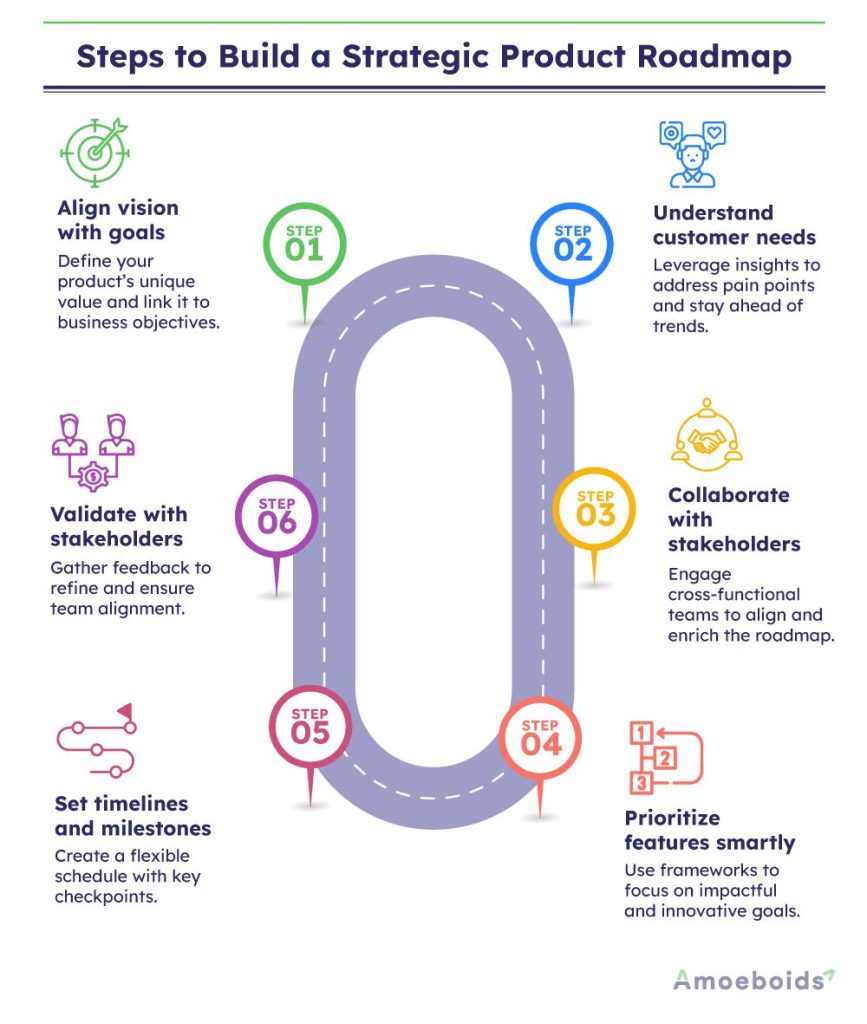
Your SaaS product can be compared to a ship navigating through ever-changing waters. But how can you direct it toward market success, customer satisfaction, and growth without a clear plan?
In this case, a strategic product roadmap can act as your compass. It is more than just a tactic; it is a shared goal that encourages collaboration, innovation, and adds value.
In this blog, we will discuss on how to develop a product roadmap that supports alignment, customer satisfaction, and success.
The roadmap serves as a guide and provides direction for your product. This strategic plan makes sure that all teams are aligned with the organization’s goals by defining the key elements and standards.
A product roadmap keeps you on track by organising tasks, tracking progress, and adapting to market changes. This facilitates both long-term growth and customer satisfaction.
Why Strategic Product Roadmap is Important for SaaS Companies?
Consider that you are trying to navigate a competitive market without a clear strategy. A strategic product roadmap will help you fill this gap by providing a trajectory for your product.
A product roadmap allows you to plan where you want to go next rather than guessing. When it comes to stakeholder coordination, timeliness, and resource allocation, you are making data-driven decisions. Furthermore, it is a game changer for customer satisfaction, sparking innovation and ensuring success.
6 Steps to Build a Strategic Product Roadmap
Creating a product roadmap may seem difficult, but let us go over each step in detail:

Step 1: Product Vision and Company Goals: Let us start with the big picture. What special value does your product provide? Make sure this is in line with business goals like raising sales, reaching a wider customer base, or enhancing customer retention. This clarity will serve as the foundation for all of your decisions.
Step 2: Understand customer needs and market trends: Use surveys, competitive analysis, and customer interviews to get insights. You need to understand customer’s pain points and market trends to ensure your product roadmap addresses needs and beats competitors.
Step 3: Collaborate with stakeholders (cross-functional teams): Product managers, developers, marketers, and customer success teams are among the stakeholders you should involve. Collaboration enhances alignment and perspectives, transforming the roadmap from a fragmented document into a strong vision.
Step 4: Prioritize Features Using Frameworks: Effective prioritization avoids feature overload and keeps the focus on impactful goals. Make use of frameworks such as the Kano Model to balance needs and innovation, RICE to assess potential, and MoSCoW to classify features.
Step 5: Create a high-level timeline and milestones: Describe a reasonable schedule with significant checkpoints, like feature rollouts or beta launches. Avoid being too strict; in order to adapt to changes, flexibility is essential.
Step 6: Validate the product roadmap with stakeholders: Present the product roadmap to important parties for their input. Validation helps to identify blind spots and ensures that all relevant teams are on board.
Measuring the Success of your Strategic Product Roadmap
How do you know whether your product roadmap is effective? Metrics and feedback are your best companions here.
- Key Metrics for SaaS Products: You can evaluate your product roadmap’s effectiveness using key metrics like user adoption rates, churn rates, and CSAT scores. These metrics are used to evaluate the overall usefulness of new innovations, retention improvements, and feature usage.
- Collecting and Analysing User Feedback: To learn how customers react to features that have been delivered, use surveys, interviews, and usage data analysis. Make use of these insights to improve subsequent iterations of the roadmap.
Common Pitfalls and How to Avoid Them
Every roadmap has its challenges, but knowing what to look for can make all the difference.
- Overloading the Roadmap with Features: Keep in mind that having too many features can make it harder to focus. Give top priority to your projects that meet customer needs and business goals.
- Ignoring stakeholder input: Neglecting your team’s insights can lead to misalignment. Engage stakeholders on a regular basis to ensure their commitment.
- Lack of regular updates and reviews: A static roadmap becomes outdated very quickly. Plan frequent updates to take into account market conditions, priorities, and advancements.
Conclusion
A strategic product roadmap serves as your product’s north star rather than just a planning tool. Balancing planning and flexibility keeps your SaaS product competitive and in sync with customer needs and vision.
Continue to measure success using key metrics, collect user feedback, and avoid common pitfalls.
An effective product roadmap is more than just a document; it is a commitment to long-term benefits for both your customer and your company.
Create your SaaS product roadmap now, and you will see your product and business succeed!
